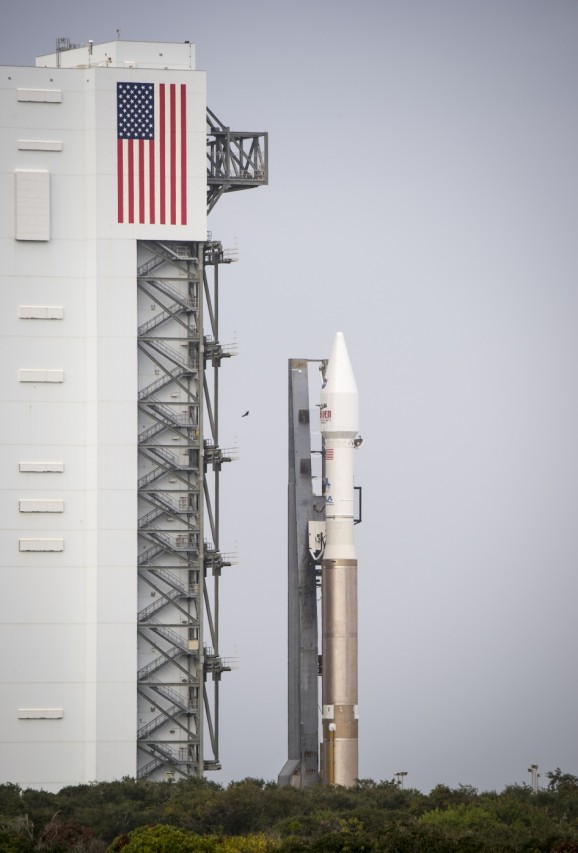Mars MAVEN Hopes To Crack The Mystery Of Mars
This article is more than 2 years old
 If the weather cooperates, tomorrow will mark another step in our long journey toward the Red Planet, with the launch of MAVEN. Mars has been an object of fascination for thousands of years. Our good friend Copernicus was the first person to postulate that Mars was a planet like Earth, which was one of the details in the heliocentric Solar System theory he published in 1543. From then on, astronomers have been studying the planet, and in 1965, spacecraft and probes joined the party. Mars has raised a multitude of questions, such as whether water exists there; whether little green aliens or some other life form exists or existed there; whether its moons are captured asteroids; and whether the planet could support human life. Key to that last question is Mars’s atmosphere, which is exactly what MAVEN will study.
If the weather cooperates, tomorrow will mark another step in our long journey toward the Red Planet, with the launch of MAVEN. Mars has been an object of fascination for thousands of years. Our good friend Copernicus was the first person to postulate that Mars was a planet like Earth, which was one of the details in the heliocentric Solar System theory he published in 1543. From then on, astronomers have been studying the planet, and in 1965, spacecraft and probes joined the party. Mars has raised a multitude of questions, such as whether water exists there; whether little green aliens or some other life form exists or existed there; whether its moons are captured asteroids; and whether the planet could support human life. Key to that last question is Mars’s atmosphere, which is exactly what MAVEN will study.
Mars has changed drastically over time. It used to be warm and wet, likely supporting microbes that may have begun life on Earth, but now it’s a cold and barren desert. How did that happen? Mars used to have a thick, cloud-producing atmosphere, but over time, the atmosphere has all but vanished. Where did it go? Carl Sagan believes it’s trapped in the soil of Mars and that it might even be possible to release the atmosphere back into the sky, which would be one aspect of terraforming. But we don’t know, which is why we’re sending MAVEN to find out.
The $671 Mars Atmosphere and Volatile EvolutioN mission provides an in-air counterpart to the on-ground Curiosity rover. The mission will spend 10 months getting to the red planet, and is scheduled to arrive at roughly the same time as India’s methane-hunting probe. It will be the first craft to focus solely on Mars’ upper atmosphere, where it will remain for about a year, going as high as 3,864 miles and as low as 78. Gaining a better understanding of the Martian atmosphere is pivotal to our future expeditions, both manned and unmanned, on the planet.
Mars is the best candidate for interplanetary colonization, given that it’s not too close, but close enough. One of the main challenges in both going to and living on Mars is the atmosphere, which presents a host of problems. First, it’s comprised primarily of carbon dioxide—it contains only traces of oxygen, about .13% compared to Earth’s 21%. So that whole breathing thing would be an issue, but hey, that’s why there are spacesuits. The atmosphere is also very thin—only about .01% as thick as Earth’s. In fact, one would have to ascend about 120,000 feet—roughly four Mount Everests stacked on top of one another—to reach air that thin. One complication of this is heat, or lack thereof. It’s damn cold on Mars. Near the equator a summer’s day reaches temperatures of around 70 degrees, but that night it would be about -100. The average temperature is around -80, but at the poles can be close to -200. I don’t think Northface makes a coat for that range, although hey, there’s a new market if we ever do colonize Mars.
Another challenge is solar radiation. Here on Earth we’ve got, at least, for now, an ozone layer that protects us from the sun’s rays. On Mars, there is no such buffer. In fact, scientists are worried about radiation exposure simply from the trip to Mars, never mind when we actually live there. The Mars One living pods could help, but many scientists believe that in order to be truly safe, colonists would have to live underground. It is, however, possible that terraforming could address these problems. MAVEN will provide crucial information in determining just how farfetched such an idea might be.
According to NASA’s website, the chance of an on-time launch tomorrow is at 60%, though weather is only one concern. Trips to Mars are notoriously difficult. Since the 1960s, international efforts at sending spacecraft to Mars succeed about 50% of the time. NASA’s success rate is about 70%. MAVEN will be its 21st launch.












